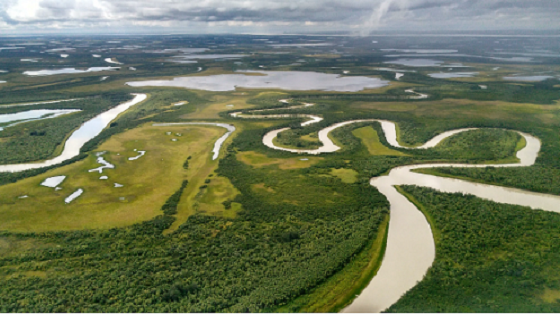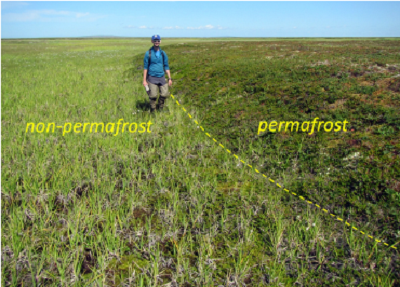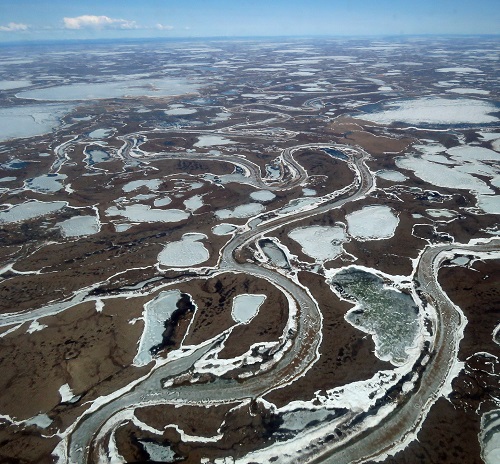Documentation Revision Date: 2021-11-17
Dataset Version: 1
Summary
There is one data file in Portable Document (*.pdf) format included in this dataset.

Figure 1. Aerial view of the Yukon Delta landscape near the village of Emmonak, August 2017. Source: Fienup-Riordan et al. (2021)
Citation
Fienup-riordan, A., G.V. Frost, R. Nayamin-kelly, U.S. Bhatt, A.S. Hendricks, M. John, and P. Odom. 2021. Alaska's Changing YK Delta: Knowledge Exchange between Elders and Geoscientists, 2018. ORNL DAAC, Oak Ridge, Tennessee, USA. https://doi.org/10.3334/ORNLDAAC/1894
Table of Contents
- Dataset Overview
- Data Characteristics
- Application and Derivation
- Quality Assessment
- Data Acquisition, Materials, and Methods
- Data Access
- References
Dataset Overview
This dataset provides a booklet documenting the discussions and outcomes from a knowledge-exchange meeting with Yup'ik elders from the Yukon-Kuskokwim Delta (YKD), western Alaska, community members, and natural scientists to discuss landscape and weather changes that have been observed in their homelands. The meeting was held from 2018-11-14 to 2018-11-16. Yup'ik participants represented several YKD villages that occupy very different biophysical environments, and they have lifelong perspectives of environmental conditions and change that predate the era of Earth-observing satellites by many decades. Nearly 16 hours of discussion and testimonials from YKD elders were recorded during the meeting. The booklet is structured according to the environmental change processes that were discussed (e.g., coastal flooding, permafrost thaw, shrub expansion, climate change) and includes narrative summaries, quotations from participants, graphical illustrations, and examples of the field- and remote-sensing-based scientific findings, and map products developed as part of the larger ABoVE project.
Project: Arctic-Boreal Vulnerability Experiment
The Arctic-Boreal Vulnerability Experiment (ABoVE) is a NASA Terrestrial Ecology Program field campaign being conducted in Alaska and western Canada, for 8 to 10 years, starting in 2015. Research for ABoVE links field-based, process-level studies with geospatial data products derived from airborne and satellite sensors, providing a foundation for improving the analysis, and modeling capabilities needed to understand and predict ecosystem responses to, and societal implications of, climate change in the Arctic and Boreal regions.
Related Publication
Fienup-Riordan, A., G. V. Frost, R. Nayamin-Kelly, U. S. Bhatt, A. S. Hendricks, and P. Odom. 2021. Yup’ik and Cup’ik observations of Alaska’s changing Yukon-Kuskokwim Delta: results of a knowledge exchange meeting with natural scientists. ABR, Inc., Environmental Research & Services; Fairbanks, Alaska. https://doi.org/10.3334/ORNLDAAC/1894
Acknowledgments
This work was supported by NASA’s Terrestrial Ecology program through the Arctic Boreal Vulnerability Experiment (grant NNH16CP09C).
Data Characteristics
Spatial Coverage: Yukon-Kuskokwim Delta, Alaska
ABoVE Reference Locations
Domain: Core ABoVE
State/Territory: Alaska
Grid cells: All areas are in the Ah0Av0 tiles, and Bh1Bv2, Bh1Bv3, Bh1Bv4, Bh2Bv2, Bh2Bv3, Bh2Bv4, Bh3Bh2, Bh3Bv3
Spatial Resolution: NA
Temporal Coverage: 1933-01-01 to 2018-11-16
Temporal Resolution: The meeting was for 2 days
Site Boundaries: Latitude and longitude are given in decimal degrees.
| Site | Westernmost Longitude | Easternmost Longitude | Northernmost Latitude | Southernmost Latitude |
|---|---|---|---|---|
| Yukon-Kuskokwim Delta, Alaska | -166.552734 | -159.47754 | 63.433318 | 59.581633 |
Data File Information
There is one data file in Portable Document (*.pdf) format included in this dataset. It is a 40-page booklet documenting the discussions and outcomes from a knowledge-exchange meeting with Yup'ik elders from the Yukon-Kuskokwim Delta (YKD), western Alaska, community members, and natural scientists to discuss landscape and weather changes that have been observed in their homelands.
Application and Derivation
Within western Alaska’s Yukon-Kuskokwim Delta (YKD) there exists a strong confluence of environmental change processes, natural hazards, critical habitats for wildlife, and a large subsistence-based human population with high cultural vitality. Environmental changes in this Arctic environment have direct consequences for human livelihoods and well-being; therefore, an effective exchange of information between natural scientists, local residents, educators, and land managers is highly relevant. This meeting serves as a useful case study to natural scientists and Arctic residents alike about what can be achieved through the open exchange of indigenous and scientific knowledge (Fienup-Riordan et al., 2021).
Quality Assessment
Not available.
Data Acquisition, Materials, and Methods
A knowledge-exchange meeting was held from 2018-11-14 to 2018-11-16 with Yup’ik elders from the Yukon-Kuskokwim Delta (YKD), western Alaska, community members, and natural scientists to discuss landscape and weather changes that have been observed in their homelands. Yup’ik participants represented several YKD villages that occupy very different biophysical environments and have lifelong perspectives of environmental conditions and change that predate the era of Earth-observing satellites by many decades. Several participants have lived in the area since the 1930s and described changes over the years in plants, topography, and wildlife. Nearly 16 hours of discussion and testimonials from YKD elders were recorded during the meeting.

Figure 2. The Yukon-Kuskokwim Delta study area, western Alaska. The study area includes the combined extents of the mainland Yukon-Kuskokwim ecoregion (Nowacki et al., 2003) and the boundaries of the Yukon Delta National Wildlife Refuge. Source: Fienup-Riordan et al. (2021)
The booklet is structured according to the environmental change processes that were discussed under the topics of Changes in Plants, Changes in Animals, Changes in the Land, Warmer Winters and the Decline of Snow, Permafrost Thaw, Rainfall/Weather Change, Weather Indicators, Timing of Subsistence Activities, The World is Changing, and Recommendations. A few examples of the participant concerns and comments in the topic areas are provided below (quoted directly from the booklet). The booklet also contains graphical illustrations, examples of the field- and remote-sensing-based scientific findings, and map products developed as part of the larger ABoVE project.
Booklet Topics
Changes in Plants
Rapid shrub growth: “When [Alakanuk] became a village many years ago before the white men came...the whole delta area from around Akuluram Painga [the mouth of Akuluraq River]...on to the coast was no trees. The whole place was tundra. And that’s one of the stories that we used to hear. And even today in the village used to be tundra, too”.
Rapid willow growth: “Willows used to take a long time to grow, back in the ‘50s or ‘60s…. Last few years, willows and trees sometimes grow five feet in one year. And they’re appearing…where there used to be no willows”.

Figure 3. Matt Macander measuring canopy heights in a mature stand of feltleaf willows (Salix alaxensis) on the Yukon Delta near Emmonak, 2018-08-07. Source: Fienup-Riordan et al. (2021)
Permafrost Thaw
Permafrost melting: “Another thing I used to hear as a youngster was we have...mound village sites. And I used to hear that if you stand on top of these mounds, you can see the other mounds in the distance. Today if you go on one of these mounds you won’t see any of them. It’s sinking”.

Figure 4. Field photo illustrating the abrupt change in topography and vegetation along the margin of a permafrost plateau, Tutakoke River area, central YKD. Source: Fienup-Riordan et al. (2021)
Changes in Animals
Animals becoming scarce
- “I don’t know how many years now it’s been since I last saw a jackrabbit. Once in a while I see maqaruat [snowshoe hare] but even those are not the same as before. Even ptarmigan were plenty”.
- “Some animals that were rarely seen—beaver, moose, wolf—are now being hunted back home. So much moose now…. even pike”.
Decline of Snow
Warmer temperatures, lower snow amounts, less ice
- “Back when I started traveling...it was only by sled dog that I’d travel, it used to be so cold. Nowadays and all the year it is that warm, not cold anymore”.
- “Back in the ‘50s and ‘60s ice would be about five- to six-feet thick in the Yukon. And lately two-and-a-half, three feet at the most. This last spring, there was hardly any ice, it was always melted before it got to the coast”.

Figure 5. Yukon-Delta landscape between Bethel and Chevak during ice breakup in April 2016. Source: Fienup-Riordan et al. (2021)
Data Access
These data are available through the Oak Ridge National Laboratory (ORNL) Distributed Active Archive Center (DAAC).
Alaska's Changing YK Delta: Knowledge Exchange between Elders and Geoscientists, 2018
Contact for Data Center Access Information:
- E-mail: uso@daac.ornl.gov
- Telephone: +1 (865) 241-3952
References
Fienup-Riordan, A., G.V. Frost, R. Nayamin-Kelly, U.S. Bhatt, A.S. Hendricks, M. John, and P. Odom. 2021. Yup’ik and Cup’ik Observations of Alaska’s Changing Yukon-Kuskokwim Delta: results of a knowledge exchange meeting with natural scientists. ABR, Inc.—Environmental Research & Services, Fairbanks AK. 40 pp. https://doi.org/10.3334/ORNLDAAC/1894
Nowacki, G. J., P. Spencer, M. Fleming, T. Brock, and T. Jorgenson. 2003. Unified Ecoregions of Alaska: 2001. U.S. Geological Survey Open-File Report 2002-297. https://doi.org/10.3133/ofr2002297